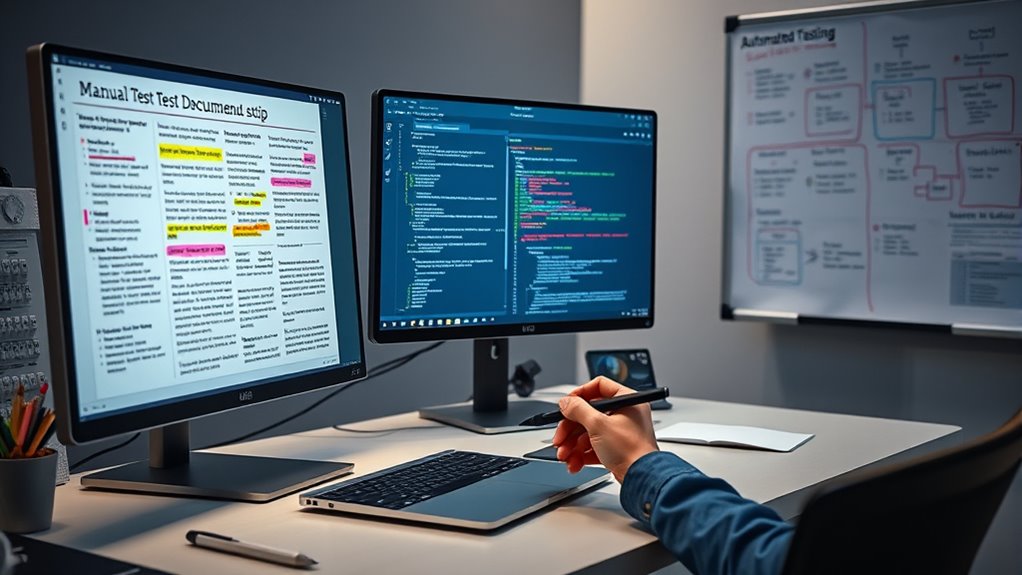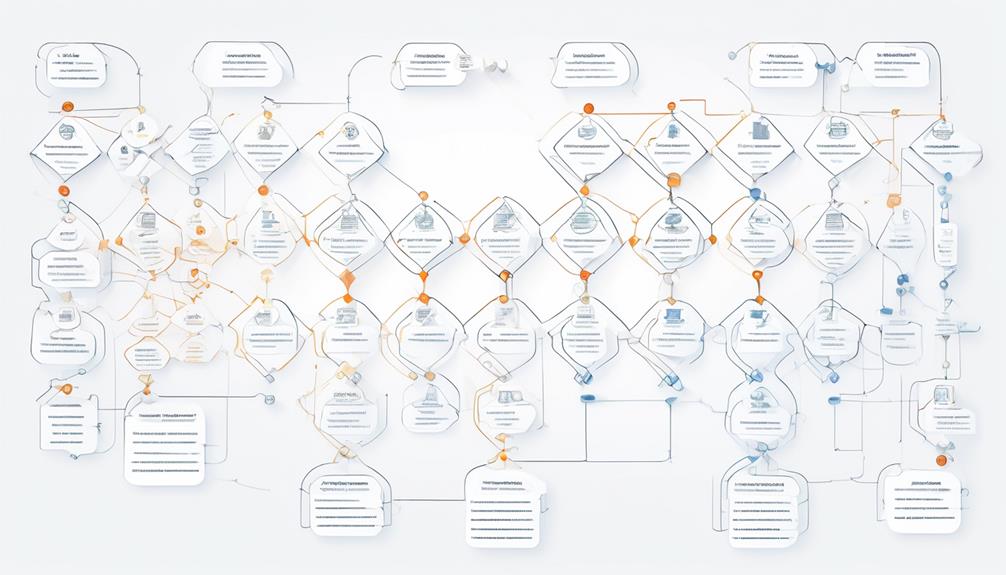To maximize value, combine automated testing for repetitive, high-volume tasks with manual testing for exploratory and usability checks. Use automation to quickly verify core functionalities and catch regressions, freeing you to focus manual efforts on complex or user-interface scenarios that need human intuition. Regularly communicate between teams to improve coverage and refine test cases. If you want to discover more about balancing these approaches effectively, keep exploring strategies to enhance your testing process.
Key Takeaways
- Use automation for repetitive, high-volume tests like regression and performance checks to save time and ensure consistency.
- Reserve manual testing for exploratory, usability, and complex scenarios requiring human intuition and creativity.
- Maintain clear communication and detailed bug reports between manual and automation teams to improve test coverage.
- Regularly review test results together to identify gaps and refine both manual and automated test cases.
- Align testing efforts with project goals to maximize efficiency, reliability, and user experience improvements.

Integrating manual and automated testing can substantially boost your software quality, but knowing how to blend the two effectively is key. When it comes to test case design, you need to identify which tests are best suited for automation and which require the nuanced touch of manual testing. Automated tests excel at repetitive, high-volume tasks like regression testing, where they can quickly verify that new code doesn’t break existing features. Manual testing, on the other hand, shines in exploratory testing and usability assessments, where human intuition uncovers issues automated scripts might miss.
Effective testing blends manual insights with automated efficiency to ensure software quality.
To create an effective testing strategy, start by mapping out your test cases. For automated testing, focus on designing test cases that are stable, repeatable, and easy to script. Clear, concise test case design reduces maintenance overhead and guarantees your automation runs smoothly. These tests should cover core functionalities, edge cases, and performance benchmarks. Meanwhile, manual test cases should target scenarios that demand creativity, such as complex user interactions or visual UI feedback, which are difficult to automate reliably. Recognizing the importance of understanding prophetic dreams and their symbolism can also enhance your approach to interpreting complex test outcomes.
Bug reporting plays an essential role in blending manual and automated testing. When an automated test fails, it’s vital to report bugs promptly and with detailed context, including logs, screenshots, and steps to reproduce. This ensures developers can quickly identify the root cause. Manual testing, however, often uncovers issues that aren’t immediately evident through automation. As such, you should encourage detailed bug reports, especially for usability problems or subtle UI glitches. Consistent bug reporting helps prioritize fixes and guides your test case adjustments, whether you need to refine your automation scripts or expand your manual test scenarios.
Effective integration also involves coordinating between manual testers and automation engineers. You should leverage automation to handle routine checks, freeing manual testers to focus on exploratory and usability testing. Additionally, regularly reviewing test results together helps identify gaps in coverage and areas where automation can be expanded. This ongoing communication ensures your testing process remains agile and all-encompassing.
Finally, keep in mind that neither manual nor automated testing alone guarantees quality. Combining the strengths of both approaches requires continuous evaluation of your test case design and bug reporting processes. By doing so, you guarantee your testing efforts are aligned with your project goals, leading to more reliable releases and a better user experience. When you blend manual and automated testing thoughtfully, you’re not just catching bugs—you’re building confidence in your software’s stability and usability.
Frequently Asked Questions
How Do I Determine Which Tests Should Be Manual or Automated?
You should start by evaluating test prioritization, considering which tests are repetitive, time-consuming, or require high precision. Manual testing is ideal for exploratory, user experience, or one-off scenarios, while automated testing suits regression, performance, and large data sets. Focus on skill development to efficiently implement automation where it *guarantees* the most value. This approach ensures you’re leveraging both testing types effectively, maximizing coverage and efficiency.
What Tools Are Best for Integrating Manual and Automated Testing?
Imagine you’re at the dawn of a new era, like a tech pioneer in a Wild West showdown. For integrating manual and automated testing, you should look for tools that excel in test management and support test automation. Platforms like TestRail, Zephyr, or Jira integrate seamlessly, letting you coordinate manual tests with automation scripts. These tools streamline workflows, increase visibility, and maximize testing efficiency, helping you achieve the best results.
How Can Team Collaboration Improve Blended Testing Strategies?
You can boost your blended testing strategies by fostering team synergy and enhancing communication channels. When everyone shares insights and collaborates openly, manual and automated testers understand each other’s roles better, leading to more effective testing. Regular meetings, clear documentation, and using collaborative tools ensure seamless information flow. As a result, your team works more cohesively, identifying issues faster and optimizing testing processes for maximum value.
What Are Common Pitfalls When Combining Manual and Automated Testing?
They say, “Don’t put all your eggs in one basket,” and that’s true for combining manual and automated testing. A common pitfall is neglecting test coverage, leaving gaps that risk missed issues. Over-relying on automation can overlook nuanced user experiences, while manual testing might miss repetitive bugs. Balance your efforts, focus on thorough risk assessment, and guarantee both methods complement each other to maximize testing efficiency and coverage.
How Do I Measure the Effectiveness of a Blended Testing Approach?
You measure the effectiveness of your blended testing approach by tracking test coverage and defect detection rates. Guarantee manual tests cover complex or critical areas, while automation handles repetitive tasks, increasing coverage. Monitor defect detection to identify gaps, and analyze trends over time. Regular reviews help you optimize efforts, improving overall quality. This approach ensures you’re efficiently catching issues and maximizing the value of both manual and automated testing efforts.
Conclusion
So, after all this talk about balancing manual and automated testing, you might think it’s a perfect science. But honestly, don’t be surprised if your brilliant plan occasionally throws you a curveball. Sometimes, manual testing uncovers what automation misses, and vice versa. The real secret? Embrace the chaos and enjoy the irony—your best results often come from knowing when to trust the machines and when to trust your instincts. Happy testing!









